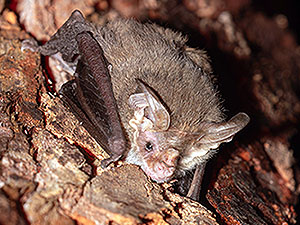Lord Howe Long-eared Bat (Nyctophilus howensis)
The Lord Howe Long-eared Bat, described in 1975, is known from a single subfossil specimen, an incomplete skull that had been found some years prior on a ledge in the Gooseberry Cave on Lord Howe Island; the age of this skull was estimated to be between 100 and 50 years.
There is also an account from the late 1800s that may be referrable to this species.:
“The only indigenous lower mammals existing on Lord Howe are bats, but even these are not plentiful. A single specimen of Scotophilus morio, Gray [Chocolate Wattled Bat (Chalinolobus morio (Gray))], similar to those obtained by Morton was shot by Mr. Unwin, and a larger species was occasionally seen. The “gardens” and other clearings are their favourite haunts, but they are sometimes seen flying around the cottages.” [1]
All attempts to find additional bone material or even living specimens of the species were unsuccessful and it is now considered extinct.
***
The photo below shows the closely related Lesser Long-eared Bat (Nyctophilus geoffreyi Leach) which is found in continental Australia where it appears to be quite common and widespread.
*********************

Photo: Isaac Clarey
https://www.inaturalist.org/people/isaacclarey
https://creativecommons.org/licenses/by-nc/4.0/
*********************
References:
[1] Robert Etheridge: The general zoology of Lord Howe Island; containing also an account of the collections made by the Australian Museum Collecting Party, Aug.-Sept., 1887. Australian Museum Memoir 2(1): 1-42. 1889
*********************
edited: 27.02.2024
